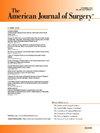Standard spontaneous breathing trial parameters may not predict unplanned reintubation for trauma patients
IF 2.7
3区 医学
Q1 SURGERY
引用次数: 0
Abstract
Background
The applicability of spontaneous breathing trial (SBT) factors such as negative inspiratory force (NIF) and rapid shallow breathing index (RSBI) as predictors of reintubation in trauma patients (TPs) is unclear. This study aimed to identify predictors of unplanned reintubation (UR) in TPs.
Methods
A single center, retrospective (1/2017–12/2023) study of TPs ≥18 years-old extubated from endotracheal mechanical ventilation was performed. Patients with UR during admission were compared to patients without UR. A multivariable logistic regression was performed to identify risk factors associated with UR.
Results
39 of 424 TPs (9.2 %) had UR. UR patients were older (median: 55 vs 39 years-old, p = 0.012) and more often had congestive heart failure (10.3 % vs 1.6 %, p < 0.001), cirrhosis (7.7 % vs 1.9 %, p = 0.025), end stage renal disease (7.7 % vs 1.6 %, p = 0.044), and a higher injury severity scores (ISS) (median: 27 vs 18, p < 0.001). UR patients had increased ventilator days (median: 6 vs 2, p < 0.001) prior to extubation, whereas RSBI and NIF were similar (median: 36 vs 32, p = 0.508) and (median: −24.0 vs −27.0 cm H2O, p = 0.190). On multivariable analysis, RSBI <50 or <105 and NIF < -20 were not associated with UR. Age (OR 1.03, CI 1.01–1.05, p = 0.006) and ISS (OR 1.04, CI 1.01–1.08, p = 0.022) were independently associated with increased risk of UR.
Conclusions
SBT parameters (RSBI and NIF) were not associated with UR. Age and ISS were independently associated with UR. This suggests additional patient-specific factors should help guide extubation decisions for TPs.

求助全文
约1分钟内获得全文
求助全文
来源期刊
CiteScore
5.00
自引率
6.70%
发文量
570
审稿时长
56 days
期刊介绍:
The American Journal of Surgery® is a peer-reviewed journal designed for the general surgeon who performs abdominal, cancer, vascular, head and neck, breast, colorectal, and other forms of surgery. AJS is the official journal of 7 major surgical societies* and publishes their official papers as well as independently submitted clinical studies, editorials, reviews, brief reports, correspondence and book reviews.

 求助内容:
求助内容: 应助结果提醒方式:
应助结果提醒方式:


